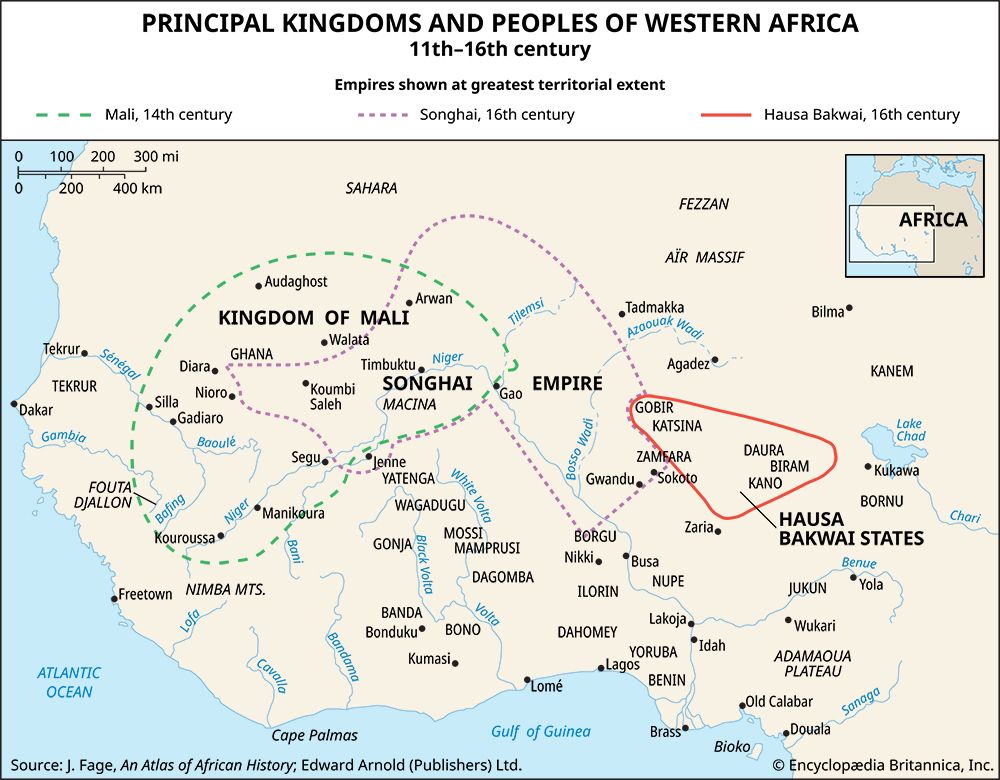Mali
Our editors will review what you’ve submitted and determine whether to revise the article.
- Ancient Origins - The Mali Empire: The Rise of the Richest Civilization in West Africa
- World History Encyclopedia - Mali Empire
- GlobalSecurity.org - Kingdom of Mali
- The History Files - Mandingo Kingdom of Kangaba
- Humanities LibreTexts - Mali Empire
- Mises Institute - The Mali Empire: An African story of gold and greatness
- Universiti Malaya - SEJARAH: Journal of the Department of History - The Vicissitudes of Mali's Empire
- UCL Discovery - The ‘Pays Dô’ and the origins of the Empire of Mali
- National Geographic - The Mali Empire
- Date:
- c. 1000 - c. 1600
- Key People:
- Ibn Battuta
- Musa I of Mali
- Sundiata Keita
- Related Topics:
- Malinke
- Related Places:
- Mali
- Mauritania
- Guinea
- Kangaba
Mali, trading empire that flourished in western Africa from the 13th to the 16th century. The Mali empire developed from the state of Kangaba, on the upper Niger River east of the Fouta Djallon, and is said to have been founded before 1000 ce. The Malinke inhabitants of Kangaba acted as middlemen in the gold trade during the later period of ancient Ghana. Their dislike of the Susu chief Sumanguru’s harsh but ineffective rule provoked the Malinke to revolt, and in 1230 Sundiata, the brother of Kangaba’s fugitive ruler, won a decisive victory against the Susu chief. (The name Mali absorbed the name Kangaba at about this time.)
In extending Mali’s rule beyond Kangaba’s narrow confines, Sundiata set a precedent for successive emperors. Imperial armies secured the gold-bearing lands of Bondu and Bambuk to the south, subdued the Diara in the northwest, and pushed along the Niger as far north as Lac Débo. Under Mansa Mūsā (1307–32?), Mali rose to the apogee of its power. He controlled the lands of the middle Niger, absorbed into his empire the trading cities of Timbuktu and Gao, and imposed his rule on such south Saharan cities as Walata and on the Taghaza region of salt deposits to the north. He extended the eastern boundaries of his empire as far as the Hausa people, and to the west he invaded Takrur and the lands of the Fulani and Tukulor peoples. In Morocco, Egypt, and elsewhere he sent ambassadors and imperial agents and on his return from a pilgrimage to Mecca (1324) established Egyptian scholars in both Timbuktu and Gao.
By the 14th century the Dyula, or Wangara, as the Muslim traders of Mali came to be called, were active throughout western Africa. The tide that had carried Mali to success, however, impelled it ineluctably to decline. The empire outgrew its political and military strength: Gao rebelled (c. 1400); the Tuareg seized Walata and Timbuktu (1431); the peoples of Takrur and their neighbours (notably the Wolof) threw off their subjection; and the Mossi (in what is now Burkina Faso) began to harass their Mali overlord. By about 1550 Mali had ceased to be important as a political entity.














